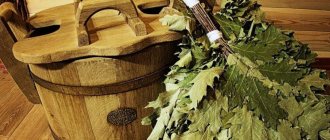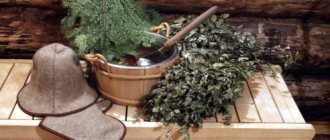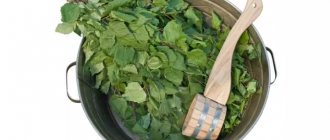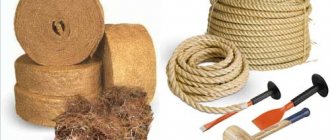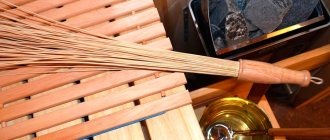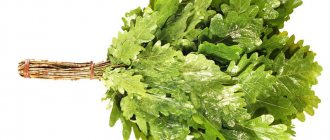A bath broom can be knitted from different types of trees. Let's figure out which material should be preferred and how to make a broom from it that will not fall off after steaming.
Bath procedures strengthen the immune system, improve metabolism, remove toxins from the body, rejuvenate the skin, relieve hangovers, calm nerves and relax. The main “working tool” that creates a unique atmosphere and creates a pleasant microclimate is a bath broom.
Popular bath brooms
The bath brooms described below not only steam well, but also have valuable healing properties.
Birch broom for a bath
This broom is a real symbol of the Russian bath. Birch is the most popular and versatile tree species, a truly magical guest from the plant world. Its leaves contain vitamins A and C, essential oils and tannins. When heated, they are released in huge quantities, disinfecting the air and destroying microbes.
Birch broom is used to prevent pulmonary diseases, colds and bronchitis, and improves the health of heavy smokers. It improves tone, stimulates blood circulation, and relieves swelling. A good treatment with a birch broom smooths out wrinkles, improves skin color, eliminates acne and heals wounds.
Oak broom for a bath
Many bathhouse connoisseurs prefer an oak broom. The king of Russian forests also has a lot of useful qualities. It will be especially useful for those with oily skin who want to relieve inflammation and heal old wounds. After it, the skin acquires a clean, matte shade and becomes smooth.
“The Oak Doctor” comes to the aid of hypertensive patients, professional athletes, and people whose activities involve nervous work. It lowers blood pressure, instantly calms and relaxes, making you forget about problems. Doctors recommend oak brooms for those who have excessive sweating associated with an unpleasant odor.
Unlike a birch broom, an oak broom produces more steam and can be taken with you several times. True, in the bath it will turn out to be heavier than the birch one and you will have to wave it harder.
Linden broom for bath
In winter, such a broom becomes especially relevant. During the cold season, the immune system and general condition of the body are undermined by the lack of fresh fruits and vegetables, cloudy weather and darkness. A linden broom will help you cheer up.
It prevents the development of colds and inflammatory processes, stimulates the immune system, relieves headaches and eliminates insomnia. And if you wash down your trip to the bathhouse with linden decoction instead of the usual drinks, you can consider yourself a renewed healthy person.
A linden broom can replace a beauty salon - it perfectly whitens the skin, heals scars and marks left from pimples and acne and after removing freckles.
Benefit for health
Whipping with a broom has a healing effect on the skin, increases blood circulation, and promotes the removal of toxins through active sweating. Essential oils and phytoncides contained in the leaves and bark actively interact with heated skin, neutralizing pathogens. The result is a high-intensity massage that complements the therapeutic effect of steaming.
The use of a broom activates the production of phagocytes and lymphocytes (cells of the immune system). They fight bacteria and viruses that enter the human body. Thanks to this, the symptoms of the disease are reduced and the recovery time is reduced. Active massage with a broom helps get rid of headaches and insomnia. Many plants contain substances that slow down skin aging. The process of active massage itself has a good effect on the joints and lymphatic system.
Coniferous brooms for baths
They include various subspecies. This includes cedar , fir , spruce and other bath brooms. They are less popular because of their “rudeness,” since not every amateur steamer can withstand being whipped with needles. And for people with delicate skin or diseases of its upper layers, such procedures are completely contraindicated.
If you handle the pine broom improperly, you can scratch the surface of the skin, which will negate the beneficial effect.
Needles are a rare material in terms of their healing effects. It is used in the treatment of tuberculosis and rheumatism, serious lung diseases, toothache and headaches, for relaxation and calming frayed nerves. Additionally, you receive a free aromatherapy session, because the smell of fresh pine needles can be compared to nothing in terms of the power of positive influence.
The best part is that you can prepare a pine broom at any time of the year.
To reduce the “prickliness” of a coniferous broom, add deciduous branches around its perimeter and steam longer.
Physics in the steam room
The heated air in the steam room rises up to the ceiling. There the temperature is above 80-90 degrees. It’s cooler on the middle shelf, and the floor can feel cold from the frozen soil. The layers of air remain motionless. In the bathhouse, brooms are used to push hot air from under the ceiling toward the body.
The strongest steam room lovers climb to the top shelf. There a person warms up so much that he can plunge into the snow or an ice hole. Classic vaping involves gradually warming up the muscles. The procedure ends with a massage with brooms.
Nettle bath broom
This is a serious “home therapist”, a tough means of preventing and treating many dangerous diseases. It is not often used in the bathhouse, but if you want something extreme and unconventional, then this is the best option. Many people are probably scared by the increased pungency of nettle, but not everyone knows that after a good steaming it is already less capricious. Instead of the familiar blisters, a slight redness remains on the skin, and the vaping process itself is accompanied by a tingling sensation.
It is believed that steaming with a nettle broom improves the condition of rheumatism, helps the body cope with liver and kidney diseases, eliminates muscle spasms, and restores skin after rashes and acne.
Criterias of choice
The main criteria for choosing a bath broom are:
- rigidity;
- the chemical composition of the plant from which the bath device is made.
With hardness, everything is very clear - it determines how well the broom cleanses the skin, as well as how comfortable it is to use.
With the chemical composition, everything is somewhat more complicated. It influences a number of factors. For example, oak cleanses oily skin better. Also, different plants have different effects on the human body. So, birch has a beneficial effect on the skin.
Unusual bath brooms
Bird cherry, currant and cherry bath brooms are considered the most delicate. Bird cherry brooms have a pleasant aroma, and their leaves contain antiseptics and other beneficial substances. They promote the healing of wounds and ulcers, treat colds, strengthen hair and rejuvenate the skin.
Cherry and currant are very light, aromatic and soft. Unfortunately, they are not very durable and fall apart quickly.
By the way, no one forbids you to make combined brooms and add branches of exotic plants such as eucalyptus , mint , juniper , raspberries , chamomile , etc.
Expert advice
To make the process of preparing, storing and using birch brooms as comfortable as possible, follow the advice of experienced bath attendants:
- It is better not to use metal wire to tighten the broom. It heats up quickly and also does not provide the necessary adhesion during the steaming process.
- If possible, it is good to place brooms in a haystack under a canopy for winter storage. Dry grass perfectly controls humidity and also provides good air exchange.
- Do not dry the broom in the open sun. This way the foliage will not only lose its color and shape, but will also lose all its beneficial substances. Steaming with such a broom will not be a pleasure: the branches will be prickly and the foliage will fall off.
- If you do not have the opportunity to prepare birch brooms yourself, you can buy them. But here it is important not to fall for an unscrupulous seller. An excellent broom smells pleasantly of dry leaves and is free of obvious signs of damage in the form of black spots.
- Don’t rush to throw away “bald” brooms. Carry out resuscitation, saving raw materials. Carefully disassemble each broom into branches, then remove those branches that are devoid of foliage. Collect new brooms. Perhaps they will not be as fluffy, but they will be soft and fragrant as before.
- Do not harvest branches after heavy rain. The foliage should be well dried naturally. Also, do not make the cut on a very hot day between 12:00 and 18:00. Foliage withering from the heat is unlikely to please you with a pleasant aroma in the bathhouse.
- Try making a few brooms with buds. Some people like this method of preparation even more.
Experiment, get healthy, make your own sauna preparations. Nature has gifted us with an inexhaustible supply of strength, but we must be grateful for every twig we pick.
When to prepare raw materials for a broom
The best time to find and prepare brooms for a bath is mid-summer . Only at this time the leaves are as “ready” as possible to turn into a broom; they are soft, fragrant and tender. However, the start of preparations falls on Trinity, which falls at a different time every year (49 days after Easter). As a rule, this is the end of May - the first ten days of June.
With the end of the preparations, everything is also clear - after August 2 (Ilya’s Day), according to popular beliefs, there is no point in knitting any brooms, with the exception of oak ones. It is believed that the trees begin to lose their healing power and no longer have the beneficial effect that was originally present.
What raw materials are suitable for a bath broom?
It is recommended to prepare brooms in dry and warm weather. Try to immediately get rid of the temptation to pick branches from the nearest stunted fishing line. Experts do not recommend using workpieces from the following areas:
- in the area of power lines;
- near factories and factories;
- close to major highways and roads.
When cutting branches, pay attention to whether the leaves are securely attached to the base; they should not fall off from simple shaking. Choose branches without thorns, jagged edges, and those that do not drip resin.
Take care of the trees! Cut off the minimum number of branches required. Branches of young trees (up to 3 years old) are ideal for brooms - they bend well and are rich in life-giving force.
In general, there is usually no need to climb to the top of the tree for branches. However, suitable specimens usually grow closer to the ground. If we talk about birch, then the “highest class” are considered to be trees growing near water; they are usually called “weeping birch”.
You can check the “quality” of the future broom when cutting the branches. If the leaves are rough, then it is better not to take such branches. They should be smooth, soft and velvety. It is better to cut young shoots from the sides using pruners.
Do not put fresh branches in bags, sacks or bags - they may become caked and lose their elasticity. To transport home, it is better to carefully bandage future brooms and either put them in the car or carry them in your hands. Do not pull the branches tightly together; they will still need to be dried.
How to knit a broom correctly
The branches should dry for several days in a room isolated from sunlight. Next, select branches of approximately the same length or cut them. After this, you need to clear 1/3 of each branch from leaves.
Collect branches into a bundle, placing thicker branches in the center, and laying thin ones around and tying them together. All branches should bend inward, the inner side of the leaf (matte) should look toward the center of the broom, and the smooth and even outer side should look outward. The thickness of the broom should be small so that it is comfortable for the steamer to hold and use. As for the length, it is usually small - no more than 60 cm.
Tying a broom can be done in several ways. We will tell you about one original method that allows you to knit a reliable and durable broom.
To begin with, you should take two equal parts of one future broom and fold them crosswise with their bases so that one part has a margin of about 10 cm. After this, you need to tie them tightly at the intersection. Then carefully transfer the “short” broom to the “long” one, twisting it at the same time, pressing it tightly with an overlap. After this, you should additionally tie the parts of the broom 15-20 cm from the place of the first dressing. If desired, you can make another dressing, but the fluffy “tail” with leaves must be left free in any case.
For bandaging, use hemp or cotton rope, but under no circumstances tie the broom with wire. In the bath it gets very hot and the likelihood of getting a burn increases.
Correct knitting
The next important stage is knitting the prepared raw materials for the bath broom. To get a quality product, it is recommended to follow some knitting rules:
- The assembly is made from elastic and flexible branches with dense, fully blossomed foliage. All undeveloped or damaged leaves are first removed.
- The branches must have 2 or more branches to give the bundle the necessary density.
- For assembly, it is better to use branches whose length is from 40 to 55 cm, thickness - no more than 5 mm.
- One knitting must contain the required amount of material so that the diameter of the handle does not exceed 6 cm.
- Prepared branches must be knitted immediately to prevent them from premature deformation and drying out. Next, the resulting matings are subjected to long-term drying.
- The dressing can be double or single, with a distance from the butt of 5 and 12 cm.
- The branches of the formed butt should be trimmed evenly.
Important! To knit a broom, a rope or twine is used, which tightly forms the handle and prevents damage to your hands during further use of the finished product.
If desired, the rope can be replaced with plastic or metal clamps. They allow you to securely fix the handle and adjust its diameter after the product has dried. Additionally, the handle can be tied with cotton tape to prevent excessive heating of the clamps.
How to properly dry and store bath brooms
The broom should be thoroughly dried before use. The ideal option is the attic of the house or the bathhouse itself. The sun's rays do not penetrate here, and it is also possible to carefully hang the bundle with the base up. Do not waste space - hang the brooms at a sufficient distance from each other, so they will dry and ventilate better.
During drying, the broom should hang upside down
Alternatively, you can carefully lay them out on newspaper in a cool place. Brooms should be turned over daily, and if they are stored in bulk, then the lower and damp ones should be placed on top of an improvised “pile”.
After drying, suitable storage conditions must be ensured. Brooms are best preserved in cool and shade. We note the following storage options:
- on a special rack in a dressing room or other dry and ventilated room, suspended with the base up;
- in cardboard boxes with holes for ventilation. Several pieces need to be stacked carefully. When stored this way, the brooms almost never dry out and retain the shape of a regular fan;
- on the roof of a house, barn, garage or hayloft. The brooms laid with a small margin from each other are covered with hay and left in this form. Not the best option in case of heavy rain;
- at home on the balcony.
How to steam a bath broom correctly
To make steaming in a bathhouse with a broom especially pleasant, you need to properly steam it before using it. Moreover, brooms from different tree species are steamed slightly differently.
How to steam a birch broom
There are several ways to steam a birch broom. You shouldn't stress him out in boiling water. This way the branches will lose their leaves and you will be left without a broom. In this matter, more “humane” methods are preferable.
- The first is to rinse a dry broom under the tap and lower it into a basin (pan) with cold water for 2-3 minutes. Then it is placed in a bowl of warm water for 5 minutes so that it is properly soaked, and right there it is scalded with boiling water from a ladle. Afterwards, the broom steamed in water is covered with a towel or lid and left for 10 minutes. This method is good because the broom gets wet and heats up gradually and evenly, becoming flexible and elastic.
- The second method is longer. The day before going to the bathhouse, a dry broom is placed in cold water; before entering the steam room, it is taken out and, wrapped in a wet towel, placed on the shelf for 10 minutes. In the humid hot air the “bouquet” will warm up, filling it with a pleasant leafy scent. This gentle method allows you to preserve the maximum of useful and aromatic substances in birch branches.
- When steaming a broom the third method, wrap it in a damp towel for a day (as it will gradually absorb moisture), and in the steam room, the wet branches are doused with boiling water before use.
How to steam an oak broom
Oak leaves are tougher and require a slightly different approach.
- First way. First, an oak broom should be placed in boiling water for 15-20 minutes, then a cold “bath” should be given to it for 5 minutes. And after that, it is again immersed in boiling water for 3 minutes. The broom is ready!
- Second way. The broom is dipped in hot water and then placed on hot stones. The broom is steamed with its own steam. This procedure can be done 2-3 times. This will soften the leaves and aromatize the air in the steam room. Just do not apply the broom to the skin immediately from the stones - this can cause a severe burn.
- The third way was to steam a broom in the old days. It was simply placed in boiling water for 15 minutes, and then, like a bouquet, the ends were placed in hot water.
How to steam a pine broom
Steaming with a pine broom is a test for extreme sports enthusiasts. Although it has a colossal massage effect. But so that such a procedure does not create a feeling of torture, but brings pleasure and benefit, the broom must be prepared wisely. The basic rule is that the pine broom should be fresh, then the needles will not be so dry and prickly.
The pine broom is steamed for 10-15 minutes before use. A bathhouse with a pine broom is a good medicine in the fight against colds.
Spruce has thinner and sharper needles, so it takes about 30 minutes a spruce But steaming is very beneficial for them - it improves blood flow, removes toxins, and eliminates muscle pain. When working with spruce branches, you need to be careful - for people with sensitive skin, a series of injections can cause irritation.
A fir broom is placed in hot water for 15-20 minutes. It will fill the air with healing essential oils, and also help relieve coughs, calm nerves and improve sleep.
The juniper broom is steamed a little longer - 30 minutes or more. But since it is very caustic and gets very hot, you need to steam with it carefully, only lightly touching the skin. But it disinfects the air and smells pleasant.
thuja broom is rarely used in a bathhouse, although thuja is a common plant in garden plots. Its branches are not so hard and prickly, so it is enough to keep the broom in boiling water for 20 minutes. The pleasant coniferous aroma of thuja heals the air, has antimicrobial and anti-inflammatory properties, and relieves nervous tension.
How to steam a nettle broom
Nettle leaves, although prickly, are not hard and there is no need to steam them. It is enough to immerse such a broom in hot water for 2-3 minutes, and then transfer it to a bowl of cold water for the same time. This should be done several times - this alternation of heating and cooling will soften the stinging sensation of the nettle, and retain its beneficial properties and you can steam to your health!
It’s not for nothing that in the old days they said: “in a bathhouse a broom is more valuable than money.” A good broom can quickly “bring back to life” tired steamers and put sick people back on their feet. If stored properly, it will last you about 2 years.
Method number 4. Time-consuming
If you still have a long time before your bath procedures (8-10 hours), you can use this method of steaming a broom and you won’t go wrong.
To begin, take a broom and completely lower it into a deep container with cool water. After 30 minutes, you need to shake it a little, turn it over and leave it there until you attend the procedure.
Just before entering the steam room, the broom must be taken out of the water, wrapped in a wet cloth and placed on the bottom shelf for about ten minutes. Thus, its branches will remain elastic and retain all the essential oils.
